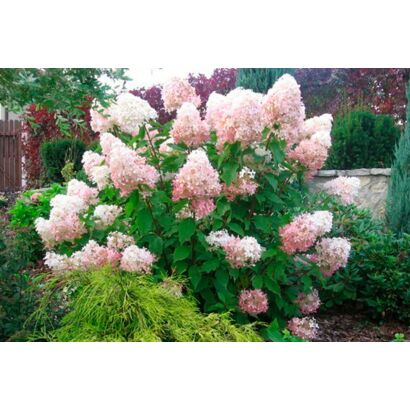Hydrangea Grandiflora (Grandiflora)
Type: paniculata
Height of the bush: 2.0 m.
Bush diameter: 3.0 m.
Inflorescences: white, pink
Flower period: July-October
Growing conditions: open ground, partial shade
| Types of hydrangeas | paniculate |
| Coloring | Pink |
Grandiflora – a popular variety of panicled hydrangea with large pyramidal inflorescences. It is used in single and group plantings, for decorating garden plots, lawns, as a hedge. In landscape design, hydrangea will look spectacular next to conifers, dwarf trees, tall flowers and herbs, bright spirea, red viburnum.
Pros of the variety: high frost resistance (up to – 40 ° C) and decorative bushes, strong stems, unpretentious care.
Appearance
Grandiflora bushes are tree-like, branched, fast-growing, reaching 2 meters in height. The crown is spherical, up to 3 meters in diameter. Hydrangea shoots are reddish-brown. The foliage is large, oval, 10-12 cm long. The leaf plate is matte, slightly pubescent.
Inflorescences are pyramidal-paniculate, large – 25-30 cm long. They consist of densely spaced, creamy white flowers that turn pink towards the end of the season. Flowering period: July-September.
Growing conditions
- The soil is slightly acidic (pH 5.0-5.5), moist, well-drained. Type: black soil, loam. Additives to the composition: humus, peat, some sand, drainage from pebbles to the bottom of the planting pit.
- Illumination of the area – partial shade, from the fence, walls, crowns of trees. No drafts.
- Watering is plentiful (15-20 l / bush), in the absence of rain at least 2 times a week.
- Feeding during the budding period with mineral fertilizers with potassium and phosphorus.
- Frost resistance up to –30°C. In regions with more severe winters, additional shelter of bushes for the winter, mulch in the form of sawdust, peat is required.
